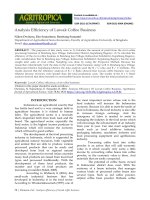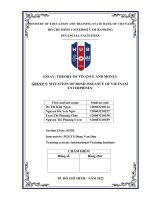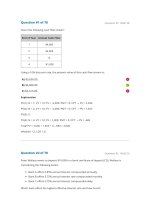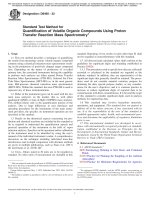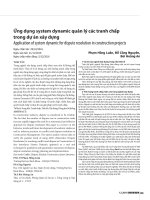Brain region-specific effects of nearly fixed sapiens-derived alleles
Bạn đang xem bản rút gọn của tài liệu. Xem và tải ngay bản đầy đủ của tài liệu tại đây (1.17 MB, 10 trang )
BMC Genomic Data
(2022) 23:36
Andirkó and Boeckx BMC Genomic Data
/>
RESEARCH
Open Access
Brain region-specific effects of nearly
fixed sapiens-derived alleles
Alejandro Andirkó1,2 and Cedric Boeckx1,2,3*
Abstract
The availability of high-coverage genomes of our extinct relatives, the Neanderthals and Denisovans, and the
emergence of large, tissue-specific databases of modern human genetic variation, offer the possibility of probing the
effects of modern-derived alleles in specific tissues, such as the brain, and its specific regions. While previous research
has explored the effects of introgressed variants in gene expression, the effects of Homo sapiens-specific gene
expression variability are still understudied. Here we identify derived, Homo sapiens-specific high-frequency (≥ 90%)
alleles that are associated with differential gene expression across 15 brain structures derived from the GTEx database.
We show that regulation by these derived variants targets regions under positive selection more often than expected
by chance, and that high-frequency derived alleles lie in functional categories related to transcriptional regulation.
Our results highlight the role of these variants in gene regulation in specific regions like the cerebellum and pituitary.
Keywords: Human evolution, Brain, cis-eQTL, Gene regulation
Significance statement
We show that almost-fixed variants distinguishing Homo
sapiens from Neanderthals and Denisovans have a previously underexplored role in the evolutionary history of
brain regions. We present evidence that these variants
accumulate in genomic regions under positive selection,
and that correlation with brain volume GWAS top hits,
suggesting a role of genetic regulation in shaping tissues
such as the cerebellum.
Introduction
Geometric morphometric analysis on endocasts [1–5]
have revealed significant differences between Neanderthal
and Homo sapiens skulls that are most likely the result of
differential growth of neural tissue. Specific brain regions
such as the cerebellum, the parietal and temporal lobes
have been hypothesized to have expanded in the Homo
sapiens lineage, with potential consequences for the evolution and diversification of cognitive skills. Probing the
*Correspondence:
ICREA, Barcelona, Spain
Full list of author information is available at the end of the article
3
nature of these consequences is challenging, but the availability of several high-quality Neanderthal and Denisovan
genomes [6–9] has opened numerous research opportunities for studying the evolution of the Homo sapiens brain
with unprecedented precision.
Efforts have been made to determine the molecular
basis of species differences based on a small number of
fixed missense mutations that are Homo sapiens-specific
[10, 11]. However, evidence is rapidly emerging in favor of
an important evolutionary role of regulatory variants, as
originally proposed more than four decades ago [12]. For
instance, regulatory variants are overrepresented in selective sweep scans to detect areas of the genome that have
been significantly affected by natural selection after the
split with Neanderthals/Denisovans [13].
The increasingly important role of gene regulation in
the evolution of Homo sapiens has led to the idea of connecting vast datasets of variation in genomic regulation to
the genetic sequences obtained from extinct humans. For
example, a major study [14] explored the effects of Neanderthal and Denisovan introgressed variants in 44 tissues
and found downregulaton by introgressed alleles in the
brain, particularly in the cerebellum and the striatum. In
© The Author(s). 2022 Open Access This article is licensed under a Creative Commons Attribution 4.0 International License,
which permits use, sharing, adaptation, distribution and reproduction in any medium or format, as long as you give appropriate
credit to the original author(s) and the source, provide a link to the Creative Commons licence, and indicate if changes were
made. The images or other third party material in this article are included in the article’s Creative Commons licence, unless
indicated otherwise in a credit line to the material. If material is not included in the article’s Creative Commons licence and your
intended use is not permitted by statutory regulation or exceeds the permitted use, you will need to obtain permission directly
from the copyright holder. To view a copy of this licence, visit The Creative
Commons Public Domain Dedication waiver ( applies to the data made
available in this article, unless otherwise stated in a credit line to the data.
Andirkó and Boeckx BMC Genomic Data
(2022) 23:36
a similar vein, another study [15] examined the effects of
extinct human introgression on brain and skull shape variability in a modern human population to determine which
variants are associated with the globularized brain and
skull that is characteristic of our lineage. In consonance
with [14], the variants with the most salient effects were
those found to affect the structure of the cerebellum and
the striatum. Crucially, for these questions to be asked, we
must move beyond fully-fixed variants, and embrace the
variation found within modern human populations.
Building on these efforts, we decided to relate derived,
modern-specific alleles found at very high frequency
across modern populations to gene expression in the
brain, in order to examine the effects of genetic variation
relative to Neanderthals and Denisovans. To this end, we
took advantage of a recent systematic review, [16], which
provides an exhaustive dataset of derived, Homo sapiens-specific alleles in modern human populations. This
dataset includes a subset of nearly-fixed (≥ 90%) variants that can determine common trends in current human
populations compared to other extinct human species.
To determine the predicted effect on gene expression of
these alleles we exploited the GTEx database. The GTEx
data consist of statistically significant allele effects on
gene expression dosage in single tissues, obtained from
tissues of adult individuals aged 20 to 60 [17]. By offering information about Expression Quantitative Trait Loci
(cis-eQTLs) across tissues, the GTEx database forces us to
think beyond variants that affect the structure and function of proteins, as well as to consider those that regulate
gene expression.
While the important role genetic regulation in human
evolution has been highlighted by previous studies
[18–21], we find that species-specific variants above a
high frequency threshold have a previously underexplored
role in human brain evolution. We show that regions
under putative positive selection are enriched in derived,
high-frequency (HF) eQTLs, and that the pituitary and
cerebellum have a significantly higher number of regulatory variability compared to other tissues and a control
set. We also show that derived alleles tend to have a downregulating effect but only when linkage disequilibrium is
not controlled for, a result that contrasts with previous
research on introgressed variants [14]. Finally, we present
a two sample Mendelian randomization analysis that correlates variability in genes related to neurodevelopment
and brain volume GWASs.
Results
We retrieved variation data from [16], a dataset that
determines Homo sapiens allele specificity using three
high-coverage archaic human genomes available at the
moment (the Altai and Vindija Neanderthals [6, 7], and a
Denisovan individual [8]).
Page 2 of 10
The variation data was crossed with the list of variants
obtained with the GTEx significant cis-eQTL variants
dataset to determine if the selected variants affect gene
expression, focusing on 15 central nervous system-related
tissues. The GTEx data consist of statistically significant
allele effects on gene expression dosage in single tissues,
obtained from brain samples of adult individuals aged 20
to 60 [17]. The resulting dataset is composed of Homo
sapiens derived alleles at high frequency that have a statistically significant effect (at a FDR threshold of 0.05, as
defined by the GTEx consortium [22]) on gene expression
in any of the selected adult human tissues.
Functional categories and tissue-specificity
In quantitative terms, our data amounts to 8,271 statistically significant SNPs associated with the regulation of a
total of 896 eGenes (i.e., genes affected by cis-regulation).
When controlling for total eQTL variance between brain
regions, a Chi-square test reveals that the proportion of
derived, HF eQTLs across tissues is significantly different
compared to the rest of non-derived, non-high-frequency
eQTLs (p < 2.2e − 16). A post-hoc residual analysis
indicates that regions such as the pituitary and the cerebellum are among the major contributors to reject the null
hypothesis that the distribution is similar between both
groups (p < 0.05). In other words, the pituitary and the
cerebellum are the two brain regions where Homo sapiens-specific eQTLs accumulate relative to the control set
of variants.
Derived eQTLs at high frequency are significantly different from the categories of the rest of GTEx eQTL variants in brain tissues (Chi-square test, p < 2.2e−16). NMD
(nonsense-mediated mRNA decay target) transcript, non
coding transcript , and 5 -UTR (untranslated region) variants are the categories driving significance (p =< 2.2e−16
for the three sets, residual analysis).
To account for linkage disequilibrium and ensure statistical independence, variant clumping was applied through
the eQTL mapping p-value at a r2 = 0.1. After clumping, the dataset was reduced to 1,270 alleles across tissues,
out of which 211 are region-specific (Fig. 1B). Because
eQTL discovery is highly dependent on the number of
tissue samples [22], tissues with more samples tend to
yield a higher number of significant variants, regardless
of tissue specificity (Fig. 1C), as shown by a Spearman
correlation test (p = 0.0017; r = 0.74, controlled for linkage disequilibrium). A polynomial regression line fit (blue
line in Fig. 1C) shows that the cerebellum, adrenal gland
and BA9 fall outside the local regression’s standard error
confidence intervals (in gray in Fig. 1C).
We sought to understand if the cerebellum, adrenal
gland and BA9 stand out considering that most eQTLs
are shared among regions. The distribution of clumped
region-specific variants (Fig. 1B) does not correlate with
Andirkó and Boeckx BMC Genomic Data
(2022) 23:36
Page 3 of 10
Fig. 1 A Hierarchical clustering analysis of eQTL normal effect size, not controlled for linkage disequilibrium (LD). Color denotes hierarchical
distance. B Number of tissue-specific eQTLs after clumping. Adrenal gland and Amygdala do not contain tissue-specific eQTL in our dataset. C Brain
region sample size and eQTL count correlate in our dataset. The blue line marks a polynomial regression line fit, with regression’s standard error
confidence intervals (95%) in gray
Andirkó and Boeckx BMC Genomic Data
(2022) 23:36
GTEx RNAseq sample size (p = 0.9495, Pearson correlation test). This lack of correlation might be explained
by known effects of genetic regulation disparity between
brain regions, reflected in distinct eQTL mappings for
cerebellar tissue [23, 24]. Additionally, we designed a random sampling testing approach (n = 100) to see if any
particular region tends to draw more clumped unique
eQTLs regardless of total eQTL values. The test reveals
no significant difference in proportions (p = 0.3647, Chisquare independence test). The fact that the adrenal gland
and the amygdala have no unique clumped variants might
be underlying this result.
Genomic regions under positive selection are enriched in
eQTLs
To determine further the evolutionary significance of any
of the variants in our data, we ran two randomization
and permutation tests (N = 1, 000) to test whether the
derived HF eQTLs fell within regions under putative positive selection relative to other hominins as identified in
two selective sweep studies [13, 25].
We found a significant (p = 0.001, observed = 525 overlapping regions, expected = 53) overlap between eQTLs
and regions of positive selection as defined by [13], as well
as in an earlier independent study [25] (p < 0.02, observed
= 673, expected = 177, Fig. 2A and B). A Wilcoxon signedrank test shows that the number of eQTLs found in
positive selection regions (visualized per region in Fig. 2C)
is significantly different between studies (p = 6.104e − 05,
after controlling for length differences in the windows
detected by each study). A Dunn test (after Bonferroni
group correction) failed to find a significant difference
between the count of alleles per region in each selective
sweep, despite the apparent concordance of the studies in
the cerebellum (Fig. 2C). We take this to mean that positive selection does not reflect a significant accumulation
of eQTL variants in any given brain region, but rather
seems to affect high-frequency derived eQTLs in general.
eQTL directionality depends on LD but not allele frequency
or brain region
A previous study [14] had suggested that Neanderthal alleles present in the modern human genetic pool downregulate gene expression in brain tissue. This study also used
the GTEx data, but focused on Neanderthal introgressed
variants as opposed to Homo sapiens-derived ones.
In our derived HF eQTL dataset (Fig. 3B), we did not
observe any significant deviance from the expected 50%
proportion between down and upregulating variants (p =
0.3656, Chi-square test). A significant deviance from the
expected 50% proportion (p < 2.2e − 16, Chi-square test)
does obtain, however, when linkage disequilibrium is not
controlled for (Fig. 3A). A hierarchical cluster analysis of
Page 4 of 10
the distance of normalized effect size between regions
in non-clumped eQTLs shows how the substantia nigra
is particularly affected by the downregulating direction
skewness effect (Fig. 1A). This contrasts with the result
found by [14], who found this downregulation effect in
cerebellum and the striatum in introgressed dataset, suggesting that variants specific to our lineage do not affect
gene expression in the brain in a particular direction.
The same deviation from the expected 50% up and
down-regulation proportion was present in major ancestral alleles at a 90% frequency threshold (p =< 2.2e − 16,
Chi-square test, Fig. 3C), discarding the possibility that
the asymmetry is due to allele frequency cutoffs. Posthoc residual analysis shows that downregulating eQTL
skewness affects different tissues in the major and minor
ancestral eQTL sets. We conclude that asymmetric directionality of eQTL regulation is not specific to a given
tissue nor is accounted for by frequency.
Derived eQTLs are correlated with top hits in brain volume
GWASs
As [14] had found that some of the introgressed variants
from Neanderthals were also top GWAS hits, we hypothesized that derived variants might also reflect some of the
changes that are characteristic of our species. We decided
to focus on structural changes beyond the cerebral cortex since these are much harder to capture by endocasts,
and they tend to be underrepresented in the brain evolution literature. By contrast, allelic effect in gene expression
can be contrasted with modern brain volume GWAS studies via two sample Mendelian randomization tests. Thus,
we chose 10 brain volume GWASs that are part of the
UKBiobank and IEU GWAS curated catalogs. We selected
four studies centered on the volume of distinct subregions
of the cerebellum (left and right white matter tracts and
cortices), as well as GWASs studying the volume of other
subcortical structures: putamen, hippocampus, amygdala,
thalamus, caudate and hippocampus (see Methods).
We first selected the top eQTL hit per gene and structure based on their eQTL p-value, under the assumption that is the variant more strongly associated with
genetic regulation, and filtered by presence in the catalog
of derived alleles by [16]. We chose not to use highfrequency variants exclusively, as pleiotropy and linkage disequilibrium may confound the results. Under a
pleiotropy model, a variant affects two different phenotypes, mixing the signal of different GWASs, while linkage
disequilibrium can affect two sample Mendelian randomization by falsely detecting causality in a high frequency
variant that is only in high LD with the real causal variant
(one not necessarily being almost fixed or derived). The
selected variants were analyzed following Wald ratio tests
per gene/structure volume associations.
Andirkó and Boeckx BMC Genomic Data
(2022) 23:36
Page 5 of 10
Fig. 2 Derived, HF eQTLs are present more than expected by chance in selective sweeps from [13] (A) and [25] (B). C shows the count of eQTL
overlapping with regions under putative positive selection per region
Andirkó and Boeckx BMC Genomic Data
(2022) 23:36
Page 6 of 10
Fig. 3 Distribution of up and down-regulating ancestral variants across different subsets of the data, in all eGenes. We include here data before (A)
and after (B) controlling for linkage disequilibrium in minor alleles (≥10% frequency). A control using major ancestral alleles (at ≥90% frequency) is
included (C)
The results (corrected by Bonferroni) highlight genes
associated with neurodevelopment and cerebellar disorders. This is consistent with the kind of phenotypes
one would expect for genes associated with brain volume GWASs. However, the importance of these results
lies on pinpointing which specific genes have been
affected over the course of Homo sapiens evolution.
Among the genes related to cerebellar volume in the
four substructure GWASs we find genes related to
ataxia (PEX7, MRPS27, PTK2 [26–28]), neurodevelopment (YPEL3, CASP6, TRIM11, GNB5 [29–32]) and
microcephaly (PDCD6IP, USP28 [33, 34]). Of note, hits
for other brain structures did not correspond with eQTL
regulation in the relevant tissue or have no identified
functional role in brain development.
To reveal if the eQTL signal was the same as those of
brain volume GWAS top hits, we ran Bayesian colocalization tests for all the eQTL that survived two sample
Mendelian Randomization. However, we found that the
probability that GWASs and derived eQTLs share the
same signal is very low (< 6%). We therefore conclude
that there is no causal relationship between eQTL expression changes and subcortical volume GWASs, and that the
relationship identified here is of correlation.
Discussion
In this study we sought to shed light on the impact of
modern-human-specific alleles found at high frequency
on gene regulation across brain regions. Our intention was
to complement previous work that focused on the effects
of introgressed variants from Neanderthals [14, 15].
We found that high-frequency derived eQTL indeed
constitute a very useful category to understand phenotypical changes specific to our lineage. As reported in the
results, these variants accumulate more than expected
relative to the control set of eQTLs in the cerebellum and
pituitary, are functionally differentiated and overrepresented in windows of the genome associated with signals
of positive selection. Also, the enrichment of 5 UTR
categories in HF derived eQTLs suggests a role for regulatory variants in Homo sapiens evolution (as discussed in
[18–20]).
Contrary to [14] we did not find a significant skewness
towards downregulation in derived eQTLs, regardless
of frequency. This downregulating effect was previously
detected as a characteristic of Neanderthal alleles introgressed in the modern human genetic pool [14]. The
derived eQTLs examined here did show directional regulatory asymmetry but only when linkage disequilibrium
was not controlled for. Additional testing indicates that
the effect is not introduced by the high frequency cutoff imposed to the data, nor introduced by the bias of a
particular region in either HF or non-HF alleles. We suggest that derived HF variants mapped as eQTLs might
affect the modern human genetic regulation landscape in
virtue of either being drivers of positive selection or being
in linkage disequilibrium with causal, positively selected
variants.
This idea is reinforced by our results in GWAS colocalization, showing that despite the correlation of eQTLs
with subcortical brain volume GWAS top hits, there is
no shared genomic signal between GWAS summary data
Andirkó and Boeckx BMC Genomic Data
(2022) 23:36
and derived variants affecting gene expression variability.
Several reasons could be put forward for this: It could be
the case that the underlying causal variants are in high
LD with derived eQTL and either (i) derived variants not
captured by eQTL mapping, or (ii) non-derived variants
that gain functionality by the effects of derived alleles in
gene expression. Even if colocalization didn’t detect causal
variants, some of the eQTLs correlated with GWAS hits
might be affecting neural phenotypes that do not leave
a clear imprint in endocasts. For example, we find that
derived variability in genes related to cerebellar development is correlated with this substructure’s volume. The
same effect was not found in other subcortical structures,
as discussed in Derived eQTLs are correlated with top hits
in brain volume GWASs section. However, the pituitary,
along with the cerebellum, has a significantly high number
of derived eQTLs relative to controls, not explained by LD
artifacts (Fig. 2B). This is relevant in light of claims that
the Hypothalamic-pituitary-adrenal (HPA) axis played a
role in the evolution of our social cognition [35, 36].
We wish to stress that our focus on brain(-related) structures in no way is intended to claim that only the brain is
the most salient locus of difference between moderns and
Neanderthals/Denisovans. While other organs undoubtedly display derived characteristics, we have concentrated
on the brain here because our primary interest lies in cognition and behavior, which is most directly affected by
brain-related changes. In addition, we want to end with
listing several limitations. First, like other current work
making use of DNA retrieved from extinct hominins, we
are constrained by the small number of high-coverage
genomes currently available. While we certainly hope that
this number will increase in the future, and yield a richer
picture of variation in our relatives, it seems to us that
despite this limitation, comparisons between us and our
closest extinct relatives in the last decade have yielded
valuable information that would not have been accessible
otherwise. Second, our work would benefit enormously
from an even better grasp of variation within human populations, and we look forward to more inclusive samplings
in the future. Third, as indicated above, the GTEx dataset
we used offers data from individuals aged 20 to 60 years.
As such, it limits our ability to probe the nature of differential effects of derived alleles at earlier developmental
stages, which are no doubt extremely relevant for all the
brain regions examined here. Our findings will therefore
have to be complemented with other methods to offer a
more comprehensive view of recent brain evolution in the
future.
Methods
We accessed the Homo sapiens variant annotation data
from [16]. The full dataset at the basis of this study is
publicly available at />
Page 7 of 10
8184038. The catalog consists of archaic-specific variants as well as all loci displaying variation within modern
populations, using the 1000 genomes project and ExAc
data to determine frequencies and the human genome
version hg19 as reference. As described in the original
article, the authors additionally imposed quality filters
pertaining to the archaic genomes: sites with less 5-fold
coverage and more than 105-fold coverage for the Altai
individual, or 75-fold coverage for the rest of archaic individuals were not taken into consideration). For ambiguous
cases, ancestrality of the relevant variant was assigned
using multiple genome aligments [37] and the macaque
reference sequence (rheMac3) [38].
For replication purposes, we wrote a script that reproduces the 90% frequency cutoff point used in the original
study. We filtered the variants according to the guidelines in [16] such that: 1) all variants show 90% allele
frequency, 2) the major allele present in Homo sapiens is
derived. Ancestrality relative to great apes is either determined by the criteria in [37] or by the macaque reference
allele in ambiguous loci. Ancestrality relative to extinct
human species relies on two possible conditions: 1) either
archaic reliable genotypes have the ancestral allele, or 2)
the Denisovan carries the ancestral allele and one of the
Neanderthals the derived allele (accounting for gene flow
from Homo sapiens to Neanderthal).
Additionally, the original study we relied on [16] applies
the 90% frequency cutoff point in a global manner: it
requires that the global frequency of an allele be more
than or equal to 90%, allowing for specific populations
to display lower frequencies. Using the metapopulation
frequency information provided in the original study,
itself derived from the 1000 Genomes Project, we applied
a more stringent filter and removed any alleles that
where below 90% in any of the five major metapopulations included (African, American, East Asian, European,
South Asian). We then harmonized and mapped the highfrequency variants to the data provided by the GTEx
database [22]. In order to do so we pruned out the alleles
that did not have an assigned rsIDs.
GTEx offers data for the following tissues of interest: Adrenal Gland, Amygdala, Caudate, Brodmann Area
(BA) 9, BA24, Cerebellum, Cerebellar Hemisphere, Cortex, Hippocampus, Hypothalamus, Nucleus Accumbens,
Pituitary, Putamen, Spinal Cord, and Substantia Nigra. Of
these samples, cerebellar hemisphere and the cerebellum,
as well as cortex and BA9, are to be treated as duplicates [17]. Although not a brain tissue per se, the Adrenal
Gland was included due to its role in the Hypothalamicpituitary-adrenal (HPA) axis, an important regulator of
the neuroendocrine system that affects behavior.
Post-mostem mRNA degradation affects the number
of discovered eQTLs in other tissues. However, we did
not control for post-mortem RNA degradation, since the
Andirkó and Boeckx BMC Genomic Data
(2022) 23:36
Central Nervous System has been shown to be relatively resistant to this effect [39]. However, re-sampled
tissues (here labeled ‘cerebellar hemisphere’ and ‘Cortex’
following the original GTEx Consortium denominations)
do show differences compared to their original samples
(‘cerebellum’ and ‘BA 9’). We acknowledge that the resulting data are limited by inherent problems of the GTEx
database, such the use of the same individuals for different brain tissue samples, the reduced discovery power of
rare variants [17], and other artifacts introduced during
RNAseq analysis.
Clumping of the variants to control for Linkage Disequilibrium was done with Plink (version 1.9) through
the ieugwasr R package [40], requiring a linkage disequilibrium score of 0.90 (i.e., co-inheritance in 90% of
cases) for an SNP to be clumped. The nominal p-value of
eQTL mapping was used as the criterion to define a top
variant; i.e., haplotypes were clumped around the most
robust eQTL candidate variant. Linkage disequilibrium
values are extracted from the 1000 Genomes project ftp
server ( />20130502/) by the ieugwasr R package.
Distance values for tissue hierarchical clustering were
calculated by using the mean values of the normalized
effect size of derived HF eQTLs.
We performed the permutation test (n=1,000) with the
R package RegioneR [41] using the unclumped data, as
variants might clump around an eQTL falling outside windows of putative positive selection, underepresenting the
number of data points inside such genomic areas and
reducing statistical power.
We ran the two sample Mendelian Randomization tests
at a p = 5e−04 threshold for top hit identification through
the ieugwasr [40], MRinstruments, and the colocalization
tests through the gwasglue package. The selected GWASs
for colocalization can be consulted in the relevant section
of the article’s code.
Figures were created with the ggplot2 R package [42]
and RegioneR [41]. All statistical tests were controlled
for power (≥ 0.8). The human selective sweep data was
extracted from Supplementary Table S5 of [25], and from
Supplementary Table S2 of [13]. GWAS summary data
and harmonized top eQTL instruments for two sample
Mendelian Randomization were extracted from the IEU
GWAS database API [40].
Acknowledgments
The Genotype-Tissue Expression (GTEx) Project was supported by the
Common Fund of the Office of the Director of the National Institutes of Health,
and by NCI, NHGRI, NHLBI, NIDA, NIMH, and NINDS. The data used for the
analyses described in this manuscript were obtained from the GTEx Portal on
November 2020.
Authors’ contributions
Conceptualization: CB & AA; Data Curation: AA; Formal Analysis: AA; Funding
Acquisition: CB; Investigation: CB & AA; Methodology: CB & AA; Software: AA;
Supervision: CB; Visualization: CB & AA; Writing — Original Draft Preparation:
Page 8 of 10
CB & AA; Writing — Review & Editing: CB & AA. The authors read and approved
the final manuscript.
Funding
This work was supported by the Spanish Ministry of Economy and
Competitiveness and the European Social Fund (BES-2017-080366); the
Spanish Ministry of Science and Innovation (grant PID2019-107042GB-I00); the
Fundació Bosch i Gimpera; a MEXT/JSPS Grant-in-Aid for Scientific Research on
Innovative Areas 4903 (Evolinguistics: JP17H06379); the Generalitat de
Catalunya (2017-SGR-341), and the support of a 2020 Leonardo Grant for
Researchers and Cultural Creators, BBVA Foundation. Funding bodies take no
responsibility for the opinions, statements and contents of this project, which
are entirely the responsibility of its authors.
Availability of data and materials
The datasets supporting the conclusions of this article can be reproduced from
the article’s Github code repository at The original eQTL data can be retrieved from [17], the [16]. The GWAS
summary data was retrieved through the ieugwasr package repository [40].
Declarations
Ethics approval and consent to participate
Not applicable.
Consent for publication
Not applicable.
Competing interests
The authors declare that they have no competing interests.
Author details
1 University of Barcelona, Barcelona, Spain. 2 University of Barcelona Institute of
Complex Systems, Barcelona, Spain. 3 ICREA, Barcelona, Spain.
Received: 2 December 2021 Accepted: 5 April 2022
References
1. Gunz P, Neubauer S, Maureille B, Hublin J-J. Brain development after
birth differs between Neanderthals and modern humans. Curr Biol.
2010;20(21):921–2. />2. Hublin J-J, Neubauer S, Gunz P. Brain ontogeny and life history in
Pleistocene hominins. Phil Trans R Soc B. 2015;370(1663):20140062.
/>3. Neubauer S, Hublin J-J, Gunz P. The evolution of modern human brain
shape. Sci Adv. 2018;4(1):5961. />4. Pereira-Pedro AS, Bruner E, Gunz P, Neubauer S. A morphometric
comparison of the parietal lobe in modern humans and Neanderthals. J
Hum Evol. 2020;142:102770. />5. Kochiyama T, Ogihara N, Tanabe HC, Kondo O, Amano H, Hasegawa K,
Suzuki H, de León MSP, Zollikofer CPE, Bastir M, Stringer C, Sadato N,
Akazawa T. Reconstructing the Neanderthal brain using computational
anatomy. Sci Rep. 2018;8(1):6296. />6. Prüfer K, Racimo F, Patterson N, Jay F, Sankararaman S, Sawyer S,
Heinze A, Renaud G, Sudmant PH, de Filippo C, Li H, Mallick S,
Dannemann M, Fu Q, Kircher M, Kuhlwilm M, Lachmann M, Meyer M,
Ongyerth M, Siebauer M, Theunert C, Tandon A, Moorjani P, Pickrell J,
Mullikin JC, Vohr SH, Green RE, Hellmann I, Johnson PLF, Blanche H,
Cann H, Kitzman JO, Shendure J, Eichler EE, Lein ES, Bakken TE,
Golovanova LV, Doronichev VB, Shunkov MV, Derevianko AP, Viola B,
Slatkin M, Reich D, Kelso J, Pääbo S. The complete genome sequence of
a Neanderthal from the Altai Mountains. Nature. 2014;505(7481):43–9.
/>7. Prüfer K, de Filippo C, Grote S, Mafessoni F, Korlevi´c P, Hajdinjak M,
Vernot B, Skov L, Hsieh P, Peyrégne S, Reher D, Hopfe C, Nagel S,
Maricic T, Fu Q, Theunert C, Rogers R, Skoglund P, Chintalapati M,
Dannemann M, Nelson BJ, Key FM, Rudan P, Ku´can Ž, Guši´c I,
Golovanova LV, Doronichev VB, Patterson N, Reich D, Eichler EE, Slatkin M,
Andirkó and Boeckx BMC Genomic Data
8.
9.
10.
11.
12.
13.
14.
15.
16.
17.
18.
19.
20.
21.
22.
(2022) 23:36
Schierup MH, Andrés AM, Kelso J, Meyer M, Pääbo S. A high-coverage
Neandertal genome from Vindija Cave in Croatia. Science.
2017;358(6363):655–8. />Meyer M, Kircher M, Gansauge M-T, Li H, Racimo F, Mallick S, Schraiber
JG, Jay F, Prüfer K, de Filippo C, Sudmant PH, Alkan C, Fu Q, Do R,
Rohland N, Tandon A, Siebauer M, Green RE, Bryc K, Briggs AW, Stenzel
U, Dabney J, Shendure J, Kitzman J, Hammer MF, Shunkov MV,
Derevianko AP, Patterson N, Andrés AM, Eichler EE, Slatkin M, Reich D,
Kelso J, Pääbo S. A High-Coverage Genome Sequence from an Archaic
Denisovan Individual. Science. 2012;338(6104):222–6. />1126/science.1224344.
Mafessoni F, Grote S, Filippo C. d., Slon V, Kolobova KA, Viola B, Markin SV,
Chintalapati M, Peyrégne S, Skov L, Skoglund P, Krivoshapkin AI,
Derevianko AP, Meyer M, Kelso J, Peter B, Prüfer K, Pääbo S. A highcoverage Neandertal genome from Chagyrskaya Cave. Proc Natl Acad Sci.
2020;117(26):15132–6. />Pääbo S. The Human Condition—A Molecular Approach. Cell.
2014;157(1):216–26. />Trujillo CA, Rice ES, Schaefer NK, Chaim IA, Wheeler EC, Madrigal AA,
Buchanan J, Preissl S, Wang A, Negraes PD, Szeto RA, Herai RH,
Huseynov A, Ferraz MSA, Borges FS, Kihara AH, Byrne A, Marin M,
Vollmers C, Brooks AN, Lautz JD, Semendeferi K, Shapiro B, Yeo GW,
Smith SEP, Green RE, Muotri AR. Reintroduction of the archaic variant of
NOVA1 in cortical organoids alters neurodevelopment. Science.
2021;371(6530). />King M, Wilson A. Evolution at two levels in humans and chimpanzees.
Science. 1975;188(4184):107–16. />1090005.
Peyrégne S, Boyle MJ, Dannemann M, Prüfer K. Detecting ancient
positive selection in humans using extended lineage sorting. Genome
Res. 2017;27(9):1563–72. />McCoy RC, Wakefield J, Akey JM. Impacts of Neanderthal-Introgressed
Sequences on the Landscape of Human Gene Expression. Cell.
2017;168(5):916–92712. />Gunz P, Tilot AK, Wittfeld K, Teumer A, Shapland CY, van Erp TGM,
Dannemann M, Vernot B, Neubauer S, Guadalupe T, Fernández G,
Brunner HG, Enard W, Fallon J, Hosten N, Völker U, Profico A,
Di Vincenzo F, Manzi G, Kelso J, St. Pourcain B, Hublin J-J, Franke B,
Pääbo S, Macciardi F, Grabe HJ, Fisher SE. Neandertal Introgression
Sheds Light on Modern Human Endocranial Globularity. Curr Biol.
2019;29(1):120–1275. />Kuhlwilm M, Boeckx C. A catalog of single nucleotide changes
distinguishing modern humans from archaic hominins. Sci Rep. 2019;9(1):
8463. />GTEx Consortium. Genetic effects on gene expression across human
tissues. Nature. 2017;550(7675):204–13. />nature24277.
Gokhman D, Nissim-Rafinia M, Agranat-Tamir L, Housman G,
García-Pérez R, Lizano E, Cheronet O, Mallick S, Nieves-Colón MA, Li H,
Alpaslan-Roodenberg S, Novak M, Gu H, Osinski JM, Ferrando-Bernal M,
Gelabert P, Lipende I, Mjungu D, Kondova I, Bontrop R, Kullmer O,
Weber G, Shahar T, Dvir-Ginzberg M, Faerman M, Quillen EE, Meissner
A, Lahav Y, Kandel L, Liebergall M, Prada ME, Vidal JM, Gronostajski RM,
Stone AC, Yakir B, Lalueza-Fox C, Pinhasi R, Reich D, Marques-Bonet T,
Meshorer E, Carmel L. Differential DNA methylation of vocal and facial
anatomy genes in modern humans. Nat Commun. 2020;11(1):1189.
/>Colbran LL, Gamazon ER, Zhou D, Evans P, Cox NJ, Capra JA. Inferred
divergent gene regulation in archaic hominins reveals potential
phenotypic differences. Nat Ecol Evol. 2019;3(11):1598–606. https://doi.
org/10.1038/s41559-019-0996-x.
Moriano J, Boeckx C. Modern human changes in regulatory regions
implicated in cortical development. BMC Genomics. 2020;21(1). https://
doi.org/10.1186/s12864-020-6706-x.
Weiss CV, Harshman L, Inoue F, Fraser HB, Petrov DA, Ahituv N,
Gokhman D. The cis-regulatory effects of modern human-specific
variants. eLife. 2021;10:63713. />The GTEx Consortium, Ardlie KG, Deluca DS, Segre AV, Sullivan TJ,
Young TR, Gelfand ET, Trowbridge CA, Maller JB, Tukiainen T, Lek M,
Ward LD, Kheradpour P, Iriarte B, Meng Y, Palmer CD, Esko T, Winckler
W, Hirschhorn JN, Kellis M, MacArthur DG, Getz G, Shabalin AA, Li G,
Page 9 of 10
23.
24.
25.
26.
27.
28.
29.
30.
31.
32.
Zhou Y-H, Nobel AB, Rusyn I, Wright FA, Lappalainen T, Ferreira PG,
Ongen H, Rivas MA, Battle A, Mostafavi S, Monlong J, Sammeth M,
Mele M, Reverter F, Goldmann JM, Koller D, Guigo R, McCarthy MI,
Dermitzakis ET, Gamazon ER, Im HK, Konkashbaev A, Nicolae DL, Cox
NJ, Flutre T, Wen X, Stephens M, Pritchard JK, Tu Z, Zhang B, Huang T,
Long Q, Lin L, Yang J, Zhu J, Liu J, Brown A, Mestichelli B, Tidwell D, Lo
E, Salvatore M, Shad S, Thomas JA, Lonsdale JT, Moser MT, Gillard BM,
Karasik E, Ramsey K, Choi C, Foster BA, Syron J, Fleming J, Magazine H,
Hasz R, Walters GD, Bridge JP, Miklos M, Sullivan S, Barker LK, Traino
HM, Mosavel M, Siminoff LA, Valley DR, Rohrer DC, Jewell SD, Branton
PA, Sobin LH, Barcus M, Qi L, McLean J, Hariharan P, Um KS, Wu S,
Tabor D, Shive C, Smith AM, Buia SA, Undale AH, Robinson KL, Roche
N, Valentino KM, Britton A, Burges R, Bradbury D, Hambright KW,
Seleski J, Korzeniewski GE, Erickson K, Marcus Y, Tejada J, Taherian M,
Lu C, Basile M, Mash DC, Volpi S, Struewing JP, Temple GF, Boyer J,
Colantuoni D, Little R, Koester S, Carithers LJ, Moore HM, Guan P,
Compton C, Sawyer SJ, Demchok JP, Vaught JB, Rabiner CA, Lockhart
NC, Ardlie KG, Getz G, Wright FA, Kellis M, Volpi S, Dermitzakis ET. The
Genotype-Tissue Expression (GTEx) pilot analysis: Multitissue gene
regulation in humans. Science. 2015;348(6235):648–60. />10.1126/science.1262110.
Sieberts SK, Perumal TM, Carrasquillo MM, Allen M, Reddy JS, Hoffman
GE, Dang KK, Calley J, Ebert PJ, Eddy J, Wang X, Greenwood AK,
Mostafavi S, Omberg L, Peters MA, Logsdon BA, Jager PLD,
Ertekin-Taner N, and LMM. Large eQTL meta-analysis reveals differing
patterns between cerebral cortical and cerebellar brain regions. Sci Data.
2020;7(1). />Sng LMF, Thomson PC, Trabzuni D. Genome-wide human brain eQTLs:
In-depth analysis and insights using the UKBEC dataset. Sci Rep. 2019;9(1):
19201. />Racimo F, Kuhlwilm M, Slatkin M. A Test for Ancient Selective Sweeps
and an Application to Candidate Sites in Modern Humans. Mol Biol Evol.
2014;31(12):3344–58. />Bird TD. Hereditary Ataxia Overview. In: Adam MP, Ardinger HH, Pagon
RA, Wallace SE, Bean LJ, Mirzaa G, Amemiya A, editors. GeneReviews .
Seattle: University of Washington; 1993. />books/NBK1138/. Accessed 26 Mar 2021.
Jiao B, Zhou Z, Hu Z, Du J, Liao X, Luo Y, Wang J, Yan X, Jiang H, Tang
B, Shen L. Homozygosity mapping and next generation sequencing for
the genetic diagnosis of hereditary ataxia and spastic paraplegia in
consanguineous families. Parkinsonism Relat Disord. 2020;80:65–72.
/>Di Gregorio E, Bianchi FT, Schiavi A, Chiotto AMA, Rolando M,
Verdun di Cantogno L, Grosso E, Cavalieri S, Calcia A, Lacerenza D,
Zuffardi O, Retta SF, Stevanin G, Marelli C, Durr A, Forlani S, Chelly J,
Montarolo F, Tempia F, Beggs HE, Reed R, Squadrone S, Abete MC,
Brussino A, Ventura N, Di Cunto F, Brusco A. A de novo X;8 translocation
creates a PTK2-THOC2 gene fusion with THOC2 expression knockdown in
a patient with psychomotor retardation and congenital cerebellar
hypoplasia. J Med Genet. 2013;50(8):543–51. />jmedgenet-2013-101542.
Blanco-Sánchez B, Clément A, Stednitz SJ, Kyle J, Peirce JL, McFadden
M, Wegner J, Phillips JB, Macnamara E, Huang Y, Adams DR, Toro C,
Gahl WA, Malicdan MCV, Tifft CJ, Zink EM, Bloodsworth KJ, Stratton KG,
Undiagnosed Diseases Network, Koeller DM, Metz TO, Washbourne P,
Westerfield M. yippee like 3(ypel3) is a novel gene required for
myelinating and perineurial glia development. PLoS Genet. 2020;16(6):
1008841. />Ferrer I. Role of caspases in ionizing radiation-induced apoptosis in the
developing cerebellum. J Neurobiol. 1999;41(4):549–58. />10.1002/(sici)1097-4695(199912)41:4<549::aid-neu10>3.0.co;2-g.
Jabbari E, Woodside J, Tan MMX, Shoai M, Pittman A, Ferrari R, Mok KY,
Zhang D, Reynolds RH, de Silva R, Grimm M-J, Respondek G, Müller U,
Al-Sarraj S, Gentleman SM, Lees AJ, Warner TT, Hardy J, Revesz T,
Höglinger GU, Holton JL, Ryten M, Morris HR. Variation at the TRIM11
locus modifies progressive supranuclear palsy phenotype. Ann Neurol.
2018;84(4):485–96. />Zhang J-H, Pandey M, Seigneur EM, Panicker LM, Koo L, Schwartz OM,
Chen W, Chen C-K, Simonds WF. Knockout of G protein beta5 impairs
brain development and causes multiple neurologic abnormalities in
mice. J Neurochem. 2011;119(3):544–54. />
Andirkó and Boeckx BMC Genomic Data
(2022) 23:36
33. Khan A, Alaamery M, Massadeh S, Obaid A, Kashgari AA, Walsh CA,
Eyaid W. PDCD6IP, encoding a regulator of the ESCRT complex, is
mutated in microcephaly. Clin Genet. 2020;98(1):80–5. />1111/cge.13756.
34. Phan TP, Maryniak AL, Boatwright CA, Lee J, Atkins A, Tijhuis A,
Spierings DC, Bazzi H, Foijer F, Jordan PW, Stracker TH, Holland AJ.
Centrosome defects cause microcephaly by activating the
53BP1-USP28-TP53 mitotic surveillance pathway. EMBO J. 2021;40(1):
106118. />35. O’Rourke T, Boeckx C. Converging roles of glutamate receptors in
domestication and prosociality. Prepr Evol Biol. 2018. />1101/439869.
36. Wrangham RW. The Goodness Paradox: The Strange Relationship
Between Virtue and Violence in Human Evolution, 1st ed. New York:
Pantheon Books; 2019.
37. Paten B, Herrero J, Fitzgerald S, Beal K, Flicek P, Holmes I, Birney E.
Genome-wide nucleotide-level mammalian ancestor reconstruction.
Genome Res. 2008;18(11):1829–43. />38. Yan G, Zhang G, Fang X, Zhang Y, Li C, Ling F, Cooper DN, Li Q, Li Y,
van Gool AJ, Du H, Chen J, Chen R, Zhang P, Huang Z, Thompson JR,
Meng Y, Bai Y, Wang J, Zhuo M, Wang T, Huang Y, Wei L, Li J, Wang Z,
Hu H, Yang P, Le L, Stenson PD, Li B, Liu X, Ball EV, An N, Huang Q,
Zhang Y, Fan W, Zhang X, Li Y, Wang W, Katze MG, Su B, Nielsen R,
Yang H, Wang J, Wang X, Wang J. Genome sequencing and comparison
of two nonhuman primate animal models, the cynomolgus and Chinese
rhesus macaques. Nat Biotechnol. 2011;29(11):1019–23. />10.1038/nbt.1992.
39. Zhu Y, Wang L, Yin Y, Yang E. Systematic analysis of gene expression
patterns associated with postmortem interval in human tissues. Sci Rep.
2017;7(1):5435. />40. Elsworth B, Lyon M, Alexander T, Liu Y, Matthews P, Hallett J, Bates P,
Palmer T, Haberland V, Smith GD, Zheng J, Haycock P, Gaunt TR,
Hemani G. The MRC IEU OpenGWAS data infrastructure. Prepr Genet.
2020. />41. Gel B, Díez-Villanueva A, Serra E, Buschbeck M, Peinado MA, Malinverni
R. regioneR: An R/Bioconductor package for the association analysis of
genomic regions based on permutation tests. Bioinformatics.
2015;btv562. />42. Wickham H. Ggplot2: Elegant Graphics for Data Analysis. New York:
Springer; 2009.
Publisher’s Note
Springer Nature remains neutral with regard to jurisdictional claims in
published maps and institutional affiliations.
Page 10 of 10


